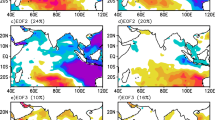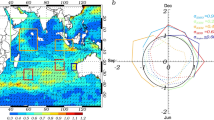Abstract
The Indian Ocean Dipole (IOD) is known as a climate mode in the tropical Indian Ocean accompanied by negative (positive) sea surface temperature (SST) anomalies over the eastern (western) pole during its positive phase. However, the western pole of the IOD is not always covered totally by positive SST anomalies. For this reason, the IOD is further classified into two types in this study based on SST anomalies in the western pole. The first type (hereafter “canonical IOD”) is associated with negative (positive) SST anomalies in the eastern (central to western) tropical Indian Ocean. The second type (hereafter “IOD Modoki”), on the other hand, is associated with negative SST anomalies in the eastern and western tropical Indian Ocean and positive SST anomalies in the central tropical Indian Ocean. Based on composite analyses, it is found that easterly wind anomalies cover the whole equatorial Indian Ocean in the canonical IOD, and as a result, positive rainfall anomalies are observed over East Africa. Also, due to the basin-wide easterly wind anomalies, the canonical IOD is accompanied by strong sea surface height (SSH) anomalies. In contrast, zonal wind anomalies converge in the central tropical Indian Ocean in the IOD Modoki, and no significant precipitation anomalies are found over East Africa. Also, only weak SSH anomalies are seen, because equatorial downwelling anomalies induced by westerly wind anomalies in the west are counteracted by equatorial upwelling anomalies caused by easterly wind anomalies in the east.















Similar content being viewed by others
References
Adler RF et al (2003) The version 2 global precipitation climatology project (GPCP) monthly precipitation analysis (1979-present). J Hydrometeorol 4:1147–1167
Annamalai H, Xie SP, McCreary JP, Murtugudde R (2005) Impact of Indian Ocean sea surface temperature on developing El Niño. J Clim 18:302–319
Ashok K, Yamagata T (2009) The El Niño with a difference. Nature 461:481–484
Ashok K, Guan Z, Yamagata T (2003) A look at the relationship between the ENSO and the Indian Ocean Dipole. J Meteorol Soc Jpn 81:41–56
Ashok K, Guan Z, Saji NH, Yamagata T (2004) Individual and combined influences of ENSO and the Indian Ocean Dipole on the Indian summer monsoon. J Clim 17:3141–3155
Ashok K, Behera SK, Rao SA, Weng H, Yamagata T (2007) El Niño Modoki and its possible teleconnection. J Geophys Res 112:C11007. doi:10.1029/2006JCOO3798
Behera S, Yamagata T (2010) Imprint of the El Niño Modoki on decadal sea level changes. Geophys Res Lett 37:L23702. doi:10.1029/2010GL045936
Behera SK, Luo JJ, Masson S, Delecluse P, Gualdi S, Navarra A, Yamagata T (2005) Paramount impact of the Indian Ocean Dipole on the East African short rains: a CGCM study. J Clim 18:4514–4530
Behera S, Ratnam J, Masumoto Y, Yamagata T (2013) Origin of extreme summers in Europe: the Indo-Pacific connection. Clim Dyn 41:663–676
Behringer D, Xue Y (2004) Evaluation of the global ocean data assimilation system at NCEP: the Pacific Ocean. Preprint, Eighth symposium on integrated observing and assimilation system for atmosphere, ocean and land surface, Seattle, WA, Am Meteorol Soc, 2.3. http://origin.cpc.ncep.noaa.gov/products/people/yxue/pub/13.pdf
Cai W, Cowan T, Raupach M (2009) Positive Indian Ocean Dipole events precondition southeast Australia bushfires. Geophys Res Lett 36:L19710. doi:10.1029/2009GL039902
Carton JA, Giese BS (2008) A reanalysis of ocean climate using simple ocean data assimilation (SODA). Mon Weather Rev 136:2999–3017
Du Y, Cai W, Wu Y (2013) A new type of the Indian Ocean Dipole since the mid-1970s. J Clim 26:959–972
Guan Z, Yamagata T (2003) The unusual summer of 1994 in East Asia: IOD teleconnections. Geophys Res Lett. doi:10.1029/2002GL016831
Hashizume M, Terao T, Minakawa N (2009) The Indian Ocean Dipole and malaria risk in the highlands of western Kenya. Proc Nat Acad Sci 106:1857–1962
Kalnay E et al (1996) The NCEP/NCAR 40-year reanalysis project. Bull Am Meteorol Soc 77:437–471
Kim ST, Yu JY (2012) The two types of ENSO in CMIP5 models. Geophys Res Lett 39:L11704. doi:10.1029/2012GL052006
Kim JS, Kim KY, Yeh SW (2012) Statistical evidence for the natural variation of the central Pacific El Niño. J Geophys Res 117:C06014. doi:10.1029/2012JC008003
Liebmann B, Smith CA (1996) Description of a complete (interpolated) outgoing longwave radiation dataset. Bull Am Meteorol Soc 77:1275–1277
Luo JJ, Masson S, Behera S, Yamagata T (2007) Experimental forecasts of Indian Ocean Dipole using a coupled OAGCM. J Clim 20:2178–2190
Luo JJ, Behera S, Masumoto Y, Sakuma H, Yamagata T (2008) Successful prediction of the consecutive IOD in 2006 and 2007. Geophys Res Lett 35:L14S02. doi:10.1029/2007GL032793
Luo JJ, Zhang R, Behera SK, Masumoto Y, Jin FF, Lukas R, Yamagata T (2010) Interaction between El Nino and extreme Indian Ocean Dipole. J Clim 23:726–742
McPhaden MJ, Lee T, McClurg D (2011) El Niño and its relationship to changing background conditions in the tropical Pacific Ocean. Geophys Res Lett 38:L15709. doi:10.1029/2011GL048275
Newman M, Shin SI, Alexander MA (2011) Natural variation in ENSO flavors. Geophys Res Lett 38:L14705. doi:10.1029/2011GL047658
Pourasghar F, Tozuka T, Jahanbakhsh S, Sari Sarraf B, Ghaemi H, Yamagata T (2012) The interannual precipitation variability in the southern part of Iran as linked to large-scale climate modes. Clim Dyn 39:2329–2341
Rao SA, Yamagata T (2004) Abrupt termination of Indian Ocean Dipole events in response to intraseasonal disturbances. Geophys Res Lett 31:L19306. doi:10.1029/2004GL020842
Rao SA, Behera SK, Masumoto Y, Yamagata T (2002) Interannual subsurface variability in the tropical Indian Ocean with a special emphasis on the Indian Ocean Dipole. Deep Sea Res II 49:1549–1572
Rao SA, Luo JJ, Behera SK, Yamagata T (2009) Generation and termination of Indian Ocean Dipole events in 2003, 2006 and 2007. Clim Dyn 33:751–767
Rayner NA, Parker DE, Horton EB, Folland CK, Alexander LV, Rowell DP, Kent EC, Kaplan A (2003) Global analysis of SST, sea ice and night marine air temperature since the late nineteenth century. J Geophys Res. doi:10.1029/2002JD002670
Saji NH, Yamagata T (2003) Possible impacts of Indian Ocean Dipole events on global climate. Clim Res 25:151–169
Saji NH, Goswami BN, Vinayachandran PN, Yamagata T (1999) A dipole mode in the tropical Indian Ocean. Nature 401:360–363
Smith TM, Reynolds RW, Peterson TC, Lawrimore J (2008) Improvements to NOAA’s historical merged land-ocean surface temperature analysis (1880–2006). J Clim 21:2283–2296
Ummenhofer CC, England MH, McIntosh PC, Meyers GA, Pook MJ, Risbey JS, Sen Gupta A, Taschetto AS (2009) What causes southeast Australia’s worst droughts? Geophys Res Lett 36:L04706. doi:10.1029/2008GL036801
Uppala SM, et al (2005) The ERA-40 re-analysis. Q J R Meteorol Soc 131 Part B:2961–3012
Weng H, Ashok K, Behera SK, Rao SA, Yamagata T (2007) Impacts of recent El Niño Modoki on dry/wet conditions in the Pacific rim during boreal summer. Clim Dyn 29:113–129
Xie PP, Arkin PA (1997) Global precipitation: a 17-year monthly analysis based on gauge observations, satellite estimates and numerical model outputs. Bull Am Meteorol Soc 78:2539–2558
Yeh SW, Kug JS, Dewitte B, Kwon MH, Kirtman BP, Jin FF (2009) El Niño in a changing climate. Nature 461:511–514
Yeh SW, Kirtman BP, Kug JS, Park W, Latif M (2011) Natural variability of the central Pacific El Niño event on multi-centennial timescales. Geophys Res Lett 38:L02704. doi:10.1029/2010GL045886
Acknowledgments
We thank two anonymous reviewers for their constructive comments. The present research is supported by the Japan Science and Technology Agency, the Japan Agency for Medical Research and Development, and the Japan International Cooperation Agency through Science and Technology Research Partnership for Sustainable Development (SATREPS).
Author information
Authors and Affiliations
Corresponding author
Rights and permissions
About this article
Cite this article
Endo, S., Tozuka, T. Two flavors of the Indian Ocean Dipole. Clim Dyn 46, 3371–3385 (2016). https://doi.org/10.1007/s00382-015-2773-0
Received:
Accepted:
Published:
Issue Date:
DOI: https://doi.org/10.1007/s00382-015-2773-0




